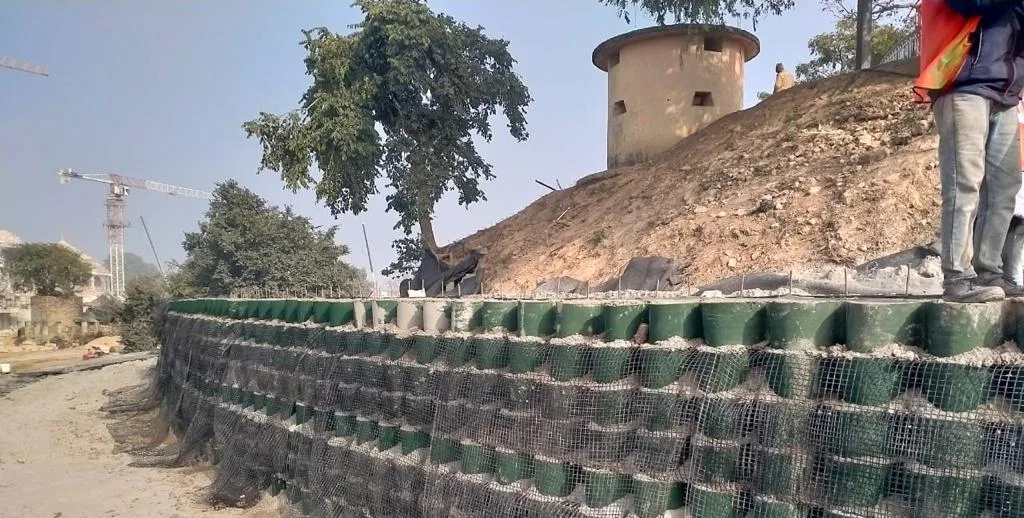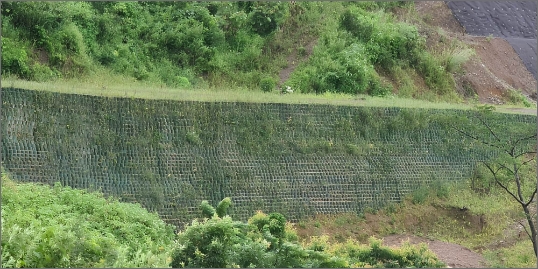Strata's reinforced soil wall chosen as solution to ensure that NASA Kennedy Space Centre remains accessible.
LOCATION
NASA Causeway, Titusville, FLL
Client
FDOT- Orion Marine- Prime,
RWH- Sub- Contractor
Product used
StrataGrid®, SGU 40, SGU 60, and SGU 80
Application
Temporary retaining wall for a new bridge approach
About the project
Initially, an aging causeway linked Titusville, FL, to the high-profile NASA Kennedy Space Center. The goal was to construct a modernized replacement bridge that required approaches on both sides of the bridge. According to the project drawings, one of the approaches needed to be located along the causeway road. One of the challenges in building this approach was that NASA required the road to remain open during construction since access was needed to the Space Center for its employees, scientists, researchers, and general staff, along with the public and dignitaries that travel in to watch the space launches and tour the facility.
Because the road needed access, the project took place in two parts. While one part of the road would be closed for construction of the bridge approach, the other part would remain open for traffic. After completion of the initial section of the approach, it would be opened for traffic while the latter portion was taken up to complete the width of the approach.
The engineering of the project carefully considered several areas, including the marshlands and surrounding environment, cost, speed of construction, and the need for a flexible structure. The final structure resulted in a mechanically stabilized earth wall with soil reinforcement and black steel wire forms. The length of the approach was 1005′ (305 m), with a maximum height of 27.5′(8.4 m).
Construction is always a challenge in this sensitive marine environment in South Florida. The system to be adopted needed to be rapidly constructed to minimize any jobsite downtimes, like those that occur in the frequent and hazardous thunderstorms common to the region. Additionally, even though temporary, the façade facing the truncated road needed to be appealing to the eye because of the high-profile traffic to the center.
Several conventional options were considered, such as soldier piles and sheet piles, but these methods were not suitable for the project’s needs. What was needed was a flexible system that was easy to install and permitted the option to remove it at the conclusion of the project, and most importantly, one that paired well with the bridge approach. And so, a temporary Strata reinforced soil retaining wall was chosen to support the temporary approach.
The temporary reinforced soil wall consists of PET uniaxial StrataGrid, SGU 40, SGU 60, and SGU 80, and locally available backfill material from the project site. These geogrids are wrapped around and protected by a face wrap of nonwoven geotextile, Strata’s ST 160. The fascia is formed by a welded steel form (see picture), which is placed to line up and level with the forms to provide an aesthetic façade. The temporary reinforced soil retaining wall supporting the access is raised simultaneously to match the height of the progressively constructed approach.
The approach was constructed to its final level and opened for traffic. The temporary reinforced soil wall by Strata was designed for the full traffic load that is expected over the bridge approach. The design life of the temporary Strata reinforced soil wall is a minimum of three years, which is well in excess of the expected time taken to complete the other portion of the approach.
It is significant to note that there was a large-diameter pipe that penetrated the face of the structure, and the temporary Strata reinforced soil wall could accommodate the obstruction in its design and detailing.
5 advantages the temporary Strata reinforced soil wall solution provided:
- Competitive cost.
- A robust reinforced soil retaining wall system.
- A flexible temporary reinforced soil retaining wall system that permits the roadway to remain open to traffic and is able to remain in place or be removed at the conclusion of the project.
- Could be detailed for working around large-diameter pipes.
- An aesthetic facade, considering the high-profile traffic along the original access road, provides access to NASA Kennedy Space Center at Cape Canaveral.
- Ease and speed of construction.

CONSULTATION
From know-how to manufacture, installation
and support
Strata not only provides geotechnical products, but our team of 200+ engineers can help you with your turnkey project by supplying you with technical knowhow and support as to how our products can help you finish your projects in time while keeping costs down.
Send us your queries and we will get back to you with our expertise.
MORE SUCCESS STORIES

Strata Geosystems uses eco-friendly solution with geogrid at KuberTila, Ram Mandir
The Kuber Tila project, located in Ram Mandir, Ayodhya is a small hillock within the temple grounds. It underpins the Ram Van Gaman path – symbolising the journey of Lord Ram from Ayodhya to Lanka. The engineering team identified the need for slope retention.

Construction of StrataWeb® Geocell Wall 32m high RS wall in the state of Manipur
This project encompasses a total length of 111 kilometers, posing the challenge of limited Right of Way (ROW) availability on either side of the proposed road’s centerline. To address this constraint, there was a need to stabilise steep slopes, manage deep cuttings, or contain filled soil within the ROW.
A total of 34 locations were identified as critical areas with deep filling requirements

Building of RS Wall Along 42KM Highway
Strata undertook a significant project involving the design and construction of Reinforced Soil (RS) wall approaches along the NH-363 highway, spanning a 42-kilometer stretch from Mancherial to Repallewada in Telangana.
The client’s primary requirement was to find a cost-effective and efficient alternative to the conventional approach of using Reinforced..
